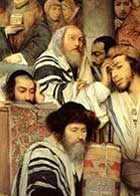Let Us Pray

"Rabbi Shimon said: make not your prayers a fixity, but a plea." The inevitable tension in prayer between practice and passion, between communal structure and the lone voice, was certainly known to the biblical prophets and the rabbis of the Talmud. Yet today, the traditional prayers—profoundly communal and reflecting ancient ideas of monarchy, patriarchy, and retribution, sometimes in complicated Hebrew—seem alien to many. If the test of contemporary Judaism is whether it offers a compelling personal experience to "the Jew within," a common liturgy becomes more difficult to maintain than ever before.
And so, the project of renewing the Siddur—the Hebrew prayer book—beckons, if in different ways. Last year, Jonathan Sacks, chief rabbi of the UK, published an affecting new edition and translation of the traditional Siddur. Just a few weeks ago, Israel's Masorti movement published a Siddur with a number of distinctly Israeli touches. The Internet's blend of the personal and the public has presented still another platform for new liturgies.
Paradoxically, today's liturgists might profit by taking a leaf from the medieval composers of liturgical verse (piyyut) who brought traditional prayer into dialogue with the poetics, and the events, of their time, honoring the ancient texts even as they re-imagined them.
Prayer has always come in many forms. The Talmud suggests at least three different ways of picturing the Song at the Sea (Exodus 15). Hannah's whispered entreaty (I Samuel 1) became a model for the Amidah, the centerpiece of the three daily prayer services. Moses' supplication for his sister—"Oh God, please heal her" (Numbers 12)—offers an enduringly eloquent standard of brevity and pathos. Recent scholarship into ancient prayer has begun to emphasize the physical as well as the textual—a useful hint to moderns that even the most elegant and updated liturgies will come to nothing without flesh-and-blood people at prayer, together and alone.
Comments are closed for this article.




